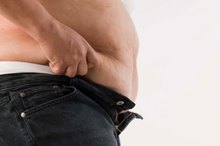What Causes Men to Have Hard Fat Bellies?
If you’re a typical adult American, you may be struggling to shed excess body fat. You store fat one of two places -- just below the skin or deep within the body cavity. The location of body fat indicates the type of fat and associated health risks. Men tend to gain weight around their waist and become apple-shaped. If you have a hard pot belly, you’re storing fat deep inside your body.
Two Types of Fat
There are two types of fat: subcutaneous and visceral. Subcutaneous fat is found just beneath your skin. White and dimply, it jiggles. Love handles and thunder thighs primarily consist of subcutaneous fat. Although you may be desperate to shed this type of fat, it cushions and insulates your body. Subcutaneous fat is also harmless. Visceral fat is yellow in color and stored in your organs, such as the pancreas and liver, and your blood vessels. It pushes against your abdominal wall and stretches your muscles until they’re taut like the surface of a drum. What results is a hard and swollen belly, according to “The Jack Sprat Low-Fat Diet: A 28-Day, Heart-Healthy Plan You Can Follow the Rest of Your Life” by Bryant Stamford.
The Risks of Visceral Fat
Foods to Avoid With the Hourglass Shape Diet
Learn More
Genetics determines how much fat you can store as subcutaneous fat. In addition, you have a limited number of fat cells. This number doesn’t fluctuate. If you put on pounds, your fat cells absorb the extra fat and grow larger. A fat cell contains toxins, triglycerides and hormones, according to Melissa Hershberg’s book “The Rebel Diet: Break the Rules, Lose the Weight.” When fat cells enlarge past a certain point, they burst. Their contents are unleashed into your bloodstream, which can lead to a wide range of problems. Higher estrogen levels can cause male breasts to form and boost the risk of breast cancer. The increased level of triglycerides can precipitate strokes and heart disease. The toxins in your blood can do damage to internal organs.
Measure of Excess Fat
You can perform a simple check for dangerous levels of excess fat by measuring your waist-to-hip ratio. Measure the circumference of your waist at the navel to the nearest quarter of an inch. Try measuring your hips from a few locations, beginning high up on your hips and working your way down. Divide the circumference of your waist by that of your hips. For a young man, the typical ratio is about 0.90, which increases to about 0.98 for older men, according to Stamford. If that ratio hits or exceeds 1, then you’re at risk of heart disease.
Losing Fat
What Is Considered a Slim Waist Size?
Learn More
For men, visceral fat can be simple and quick to lose. If you go on a diet, you’ll lose weight faster than scores of women trying to trim the subcutaneous fat off their thighs. The downside is that this fat is being dumped into your bloodstream in amounts that will affect your body in various ways. For example, your body will react by producing more cholesterol. The enlarged fat cells deep in your abdomen are also related to glucose intolerance. As they disappear into your bloodstream, your body will increase its release of insulin, which puts you at risk of Type 2 diabetes. Higher levels of insulin in the body can cause the absorption of more sodium by your kidneys, according to Stamford. You may also see a rise in your blood pressure.
Related Articles
References
- The Rebel Diet: Break the Rules, Lose the Weight; Melissa Hershberg
- The Jack Sprat Low-Fat Diet: A 28-Day, Heart-Healthy Plan You Can Follow the Rest of Your Life; Bryant A. Stamford
- Smart Exercise: Burning Fat, Getting Fat; Covert Bailey
Resources
- The Men’s Health Guide to Peak Conditioning; Richard Laliberte and Stephen C. George
Writer Bio
Kay Tang is a journalist who has been writing since 1990. She previously covered developments in theater for the "Dramatists Guild Quarterly." Tang graduated with a Bachelor of Arts in economics and political science from Yale University and completed a Master of Professional Studies in interactive telecommunications at New York University.









